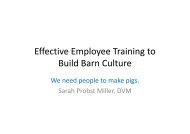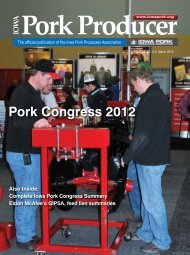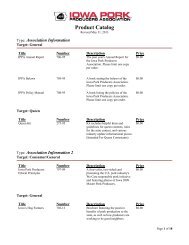September 2011 - Iowa Pork Producers Association
September 2011 - Iowa Pork Producers Association
September 2011 - Iowa Pork Producers Association
Create successful ePaper yourself
Turn your PDF publications into a flip-book with our unique Google optimized e-Paper software.
• Heat stroke<br />
• Long work periods in hot environments,<br />
especially people not used to heat<br />
• Loss of sweating capacity, disturbed mental<br />
state, possible convulsions or coma<br />
• Body temperature may exceed 105° F. (41° C.),<br />
rapid heart rate<br />
• Emergency situation, must cool rapidly;<br />
spraying or immersion in cool water, get the<br />
person to the emergency room<br />
• Prevention (see heat exhaustion above)<br />
Table 2: The serious combined effects of health and humidity.<br />
Heat Index<br />
The air temperature<br />
combined with the relative<br />
humidity (heat index) is<br />
a critical factor to watch.<br />
High temperature plus<br />
high humidity combine to<br />
create hazardous conditions.<br />
With high humidity, the<br />
sweat does not evaporate<br />
as readily compared to<br />
drier air, eliminating our<br />
most effective cooling<br />
mechanism. Table 2<br />
provides a picture and<br />
advice when the combined<br />
temperature and humidity<br />
create situations when it is “too<br />
damned hot for man or beast.”<br />
Remember, if you think it is hot, it is even hotter for<br />
pigs. If the ventilation fails in a building on a hot day,<br />
a lethal situation can develop in a matter of hours.<br />
Transportation of market hogs on hot days also is a<br />
risky proposition. The article “Keeping Pigs and People<br />
Cool” in the National <strong>Pork</strong> Board’s <strong>Pork</strong> Checkoff<br />
newsletter provides great information on keeping pigs<br />
cool when it’s hot.<br />
It has been too damned hot this summer and we can<br />
expect more to come in future years. Understanding<br />
the basic principles of heat stress and prevention – and<br />
applying them - can help us live, learn and work even<br />
through “too damned hot” spells.<br />
SEPTEMBER MAY JULY 2010 <strong>2011</strong><br />
31













